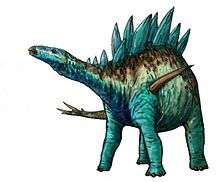Lusitanosaurus
| Lusitanosaurus Temporal range: Early Jurassic | |
|---|---|
| Scientific classification | |
| Kingdom: | Animalia |
| Phylum: | Chordata |
| Class: | Sauropsida |
| Superorder: | Dinosauria |
| Order: | Ornithischia |
| Suborder: | Thyreophora |
| Infraorder: | ?Ankylosauria |
| Family: | ?Scelidosauridae |
| Genus: | Lusitanosaurus |
| Species: | L. liasicus |
| Binomial name | |
| Lusitanosaurus liasicus Lapparent & Zbyszewski, 1957 | |
Lusitanosaurus (meaning "Portuguese lizard") is a genus of basal thyreophoran dinosaur from the Early Jurassic of Portugal.
The genus was first described by Albert-Félix de Lapparent and Georges Zbyszewski in 1957.[1] The type species is Lusitanosaurus liasicus. The generic name is derived from Lusitania, the ancient Latin name for the region. The specific name refers to the Lias.
The holotype is part of the collection of the Museu de História Natural da Universidade de Lisboa. The exact location of the find and the date of collection are unknown, which makes a correct geological dating difficult, but it can be inferred from the matrix rock that it has been discovered near São Pedro de Moel, in strata from the Sinemurian (Early Jurassic). This would make it the oldest known dinosaur from Portugal. The fossil consists of a single partial left maxilla, an upper jaw bone, with seven teeth.
Originally assigned to the Stegosauria by de Lapparent, Lusitanosaurus is today considered a basal member of the Thyreophora, perhaps belonging to the Scelidosauridae. Some authors consider it a nomen dubium.
Notes
- ↑ A.F. de Lapparent & G. Zbyszewski, 1957, "Les dinosauriens du Portugal", Mémoires des Services Géologiques du Portugal, nouvelle série 2: 1-63
References
- Antunes, M.T. & Mateus, O. (2003). Dinosaurs of Portugal. C. R. Palevol, 2: 77-95.
- Lusitanosaurus in the Paleobiology Database

